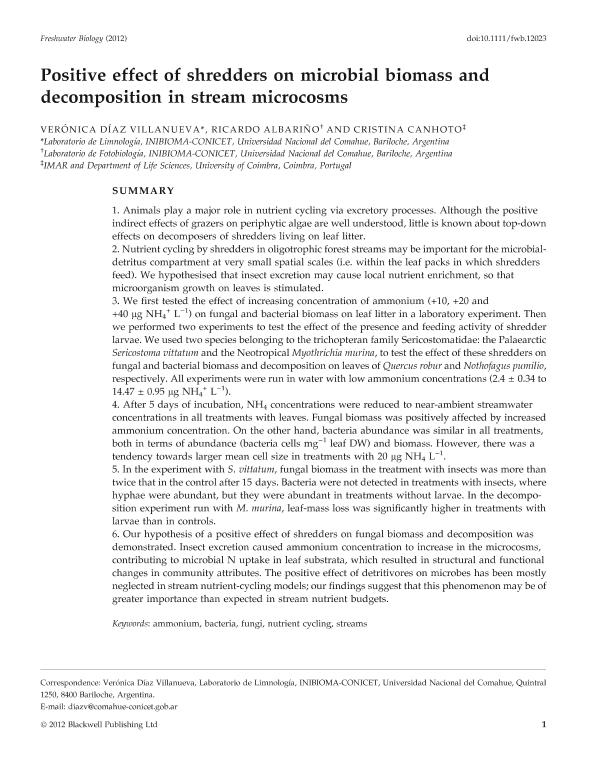Mostrar el registro sencillo del ítem
dc.contributor.author
Diaz Villanueva, Veronica

dc.contributor.author
Albariño, Ricardo Javier

dc.contributor.author
Canhoto, C.
dc.date.available
2019-02-21T13:09:08Z
dc.date.issued
2012-12
dc.identifier.citation
Diaz Villanueva, Veronica; Albariño, Ricardo Javier; Canhoto, C.; Positive effect of shredders on microbial biomass and decomposition in stream microcosms; Wiley Blackwell Publishing, Inc; Freshwater Biology (print); 57; 12; 12-2012; 2504-2513
dc.identifier.issn
0046-5070
dc.identifier.uri
http://hdl.handle.net/11336/70593
dc.description.abstract
1.Animals play a major role in nutrient cycling via excretory processes. Although the positive indirect effects of grazers on periphytic algae are well understood, little is known about top-down effects on decomposers of shredders living on leaf litter. 2.Nutrient cycling by shredders in oligotrophic forest streams may be important for the microbial-detritus compartment at very small spatial scales (i.e. within the leaf packs in which shredders feed). We hypothesised that insect excretion may cause local nutrient enrichment, so that microorganism growth on leaves is stimulated. 3.We first tested the effect of increasing concentration of ammonium (+10, +20 and +40μgNH 4 +L -1) on fungal and bacterial biomass on leaf litter in a laboratory experiment. Then we performed two experiments to test the effect of the presence and feeding activity of shredder larvae. We used two species belonging to the trichopteran family Sericostomatidae: the Palaearctic Sericostoma vittatum and the Neotropical Myothrichia murina, to test the effect of these shredders on fungal and bacterial biomass and decomposition on leaves of Quercus robur and Nothofagus pumilio, respectively. All experiments were run in water with low ammonium concentrations (2.4±0.34 to 14.47±0.95μgNH 4 +L -1). 4.After 5days of incubation, NH 4 concentrations were reduced to near-ambient streamwater concentrations in all treatments with leaves. Fungal biomass was positively affected by increased ammonium concentration. On the other hand, bacteria abundance was similar in all treatments, both in terms of abundance (bacteria cellsmg -1 leaf DW) and biomass. However, there was a tendency towards larger mean cell size in treatments with 20μgNH 4L -1. 5.In the experiment with S. vittatum, fungal biomass in the treatment with insects was more than twice that in the control after 15days. Bacteria were not detected in treatments with insects, where hyphae were abundant, but they were abundant in treatments without larvae. In the decomposition experiment run with M. murina, leaf-mass loss was significantly higher in treatments with larvae than in controls. 6.Our hypothesis of a positive effect of shredders on fungal biomass and decomposition was demonstrated. Insect excretion caused ammonium concentration to increase in the microcosms, contributing to microbial N uptake in leaf substrata, which resulted in structural and functional changes in community attributes. The positive effect of detritivores on microbes has been mostly neglected in stream nutrient-cycling models; our findings suggest that this phenomenon may be of greater importance than expected in stream nutrient budgets. © 2012 Blackwell Publishing Ltd.
dc.format
application/pdf
dc.language.iso
eng
dc.publisher
Wiley Blackwell Publishing, Inc

dc.rights
info:eu-repo/semantics/openAccess
dc.rights.uri
https://creativecommons.org/licenses/by-nc-sa/2.5/ar/
dc.subject
Ammonium
dc.subject
Bacteria
dc.subject
Fungi
dc.subject
Nutrient Cycling
dc.subject
Streams
dc.subject.classification
Otras Ciencias Biológicas

dc.subject.classification
Ciencias Biológicas

dc.subject.classification
CIENCIAS NATURALES Y EXACTAS

dc.title
Positive effect of shredders on microbial biomass and decomposition in stream microcosms
dc.type
info:eu-repo/semantics/article
dc.type
info:ar-repo/semantics/artículo
dc.type
info:eu-repo/semantics/publishedVersion
dc.date.updated
2019-02-12T16:53:57Z
dc.journal.volume
57
dc.journal.number
12
dc.journal.pagination
2504-2513
dc.journal.pais
Reino Unido

dc.journal.ciudad
Londres
dc.description.fil
Fil: Diaz Villanueva, Veronica. Consejo Nacional de Investigaciones Científicas y Técnicas. Centro Científico Tecnológico Conicet - Patagonia Norte. Instituto de Investigaciones en Biodiversidad y Medioambiente. Universidad Nacional del Comahue. Centro Regional Universidad Bariloche. Instituto de Investigaciones en Biodiversidad y Medioambiente; Argentina
dc.description.fil
Fil: Albariño, Ricardo Javier. Consejo Nacional de Investigaciones Científicas y Técnicas. Centro Científico Tecnológico Conicet - Patagonia Norte. Instituto de Investigaciones en Biodiversidad y Medioambiente. Universidad Nacional del Comahue. Centro Regional Universidad Bariloche. Instituto de Investigaciones en Biodiversidad y Medioambiente; Argentina
dc.description.fil
Fil: Canhoto, C.. Universidad de Coimbra; Portugal
dc.journal.title
Freshwater Biology (print)

dc.relation.alternativeid
info:eu-repo/semantics/altIdentifier/doi/http://dx.doi.org/10.1111/fwb.12023
dc.relation.alternativeid
info:eu-repo/semantics/altIdentifier/url/https://onlinelibrary.wiley.com/doi/abs/10.1111/fwb.12023
Archivos asociados
